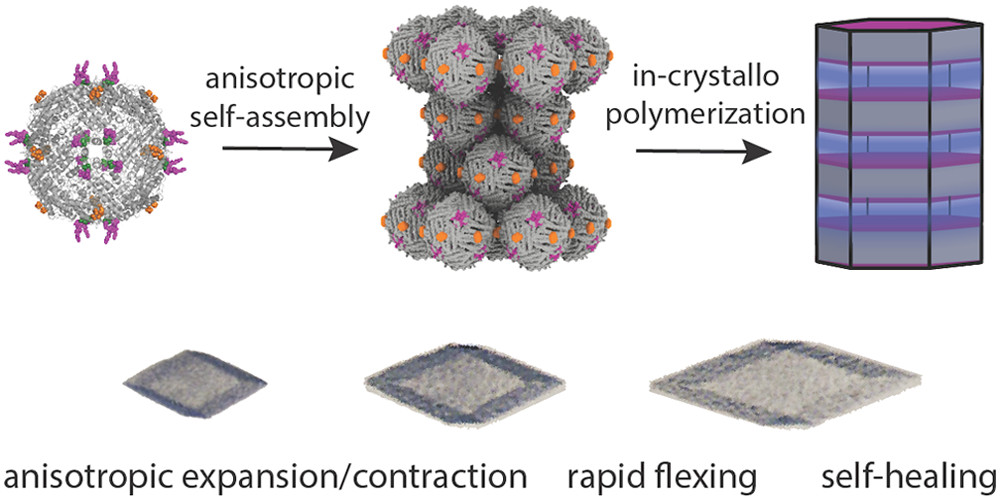Molecular Crystals Hybridized with Hydrogel Polymers Achieve Unprecedented Material Attributes
10/30/2020

Ferritin (top left) is a building block for polymer-integrated crystals (PIX). When ferritin with properties of anisotropic symmetry are conjugated with a maleimide-functionalized RAFT agent (pink), the resulting molecules can self-assemble into anisotropic crystals (center). The crystals enable the templated formation of patterned hydrogel networks (right). The resulting PIX (bottom row) expand and contract anisotropically without losing crystallinity, undergo prompt bending motions in response to stimuli, and self-heal efficiently, capturing some of the essential features of sophisticated biological devices like skeletal muscles. [Reprinted with permission from Han et al. 2020. Journal of the American Chemical Society, DOI:10.1021/jacs.0c10065. Copyright 2020 American Chemical Society.]
The ability to produce materials with desired mechanical and dynamic properties by deliberately designing their building blocks could enable a wide range of applications such as gas sorption and separation, sensing, and controlled release, among others.
The transfer and amplification of atomic or molecular-level design to the macroscopic scale requires molecular building blocks to be organized and appropriately interconnected over multiple length scales. Crystalline materials provide a distinct advantage in this regard in that they are composed of only one or few components arranged periodically, possessing both short and long-range order to allow structural and mechanical coupling in a cooperative manner.
However, the flexibility and adaptiveness of crystalline materials are rather limited, restricting the range of achievable macroscopic changes. Combining protein crystals, such as mesoporous ferritin, with hydrogel networks has resulted in hybrid materials called polymer-integrated crystals (PIX) which can undergo dramatic structural changes while maintaining crystalline periodicity and displaying efficient self-healing. But the uniform distribution and isotropic expansion/contraction of the lattice rendered the first-generation PIX materials isotropic, or lacking directionality.
A research group from the University of California San Diego led by F.A. Tezcan showed that PIX materials can be patterned by the orientation and structural details of the distinct protein−protein interfaces in non-cubic ferritin lattices to display directional expansion and contraction and rapid bending motions, while retaining crystalline order.
The process of crystal expansion and contraction was monitored in situ using small angle X-ray scattering measured at the Stanford Synchrotron Radiation Lightsource beamline 4-2, which confirmed that the cystalline lattice is intact throughout the process.
Key to attaining anisotropic properties in PIX is the ability of the ferritin molecules to form lattices with distinct symmetries and protein−protein interfaces. These differences allowed the templation of alternatively-patterned hydrogel networks in situ, which ultimately enabled ferritin crystals that possess the same macroscopic morphologies to display orthogonally directed motions.
Combined with the inherent chemical versatility and functions of proteins, such covalently hybridized PIX could offer a unique platform for the study of protein−polymer interactions and the development of biocatalytic and molecular encapsulation/delivery systems with tunable and responsive mechanical properties. For example, the hybridized PIX expand and contract anisotropically without losing crystallinity, undergo prompt bending motions in response to stimuli, and self-heal efficiently, capturing some of the essential features of sophisticated biological devices like skeletal muscles.
Related Links
References
Han, K., et al. 2020. “Anisotropic Dynamics and Mechanics of Macromolecular Crystals Containing Lattice-Patterned Polymer Networks,” Journal of American Chemical Society 142(45), 19402–410. [DOI:10.1021/jacs.0c10065]
